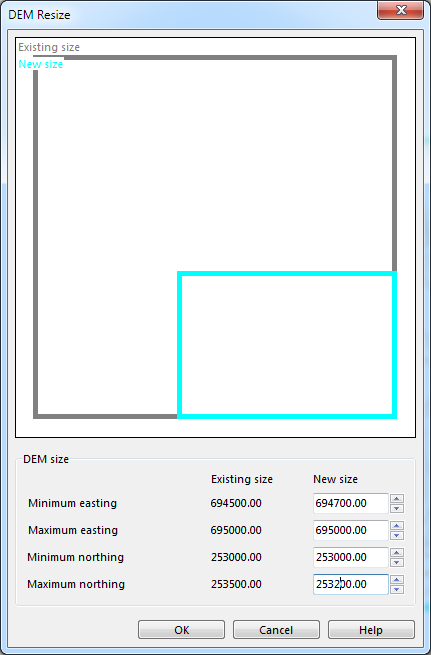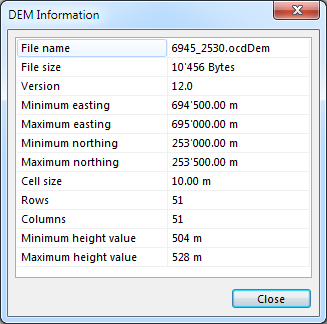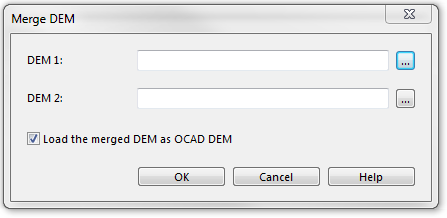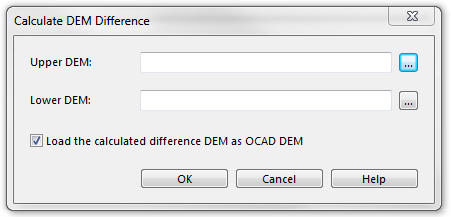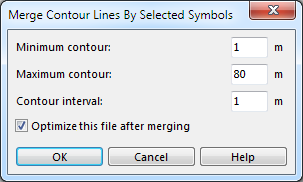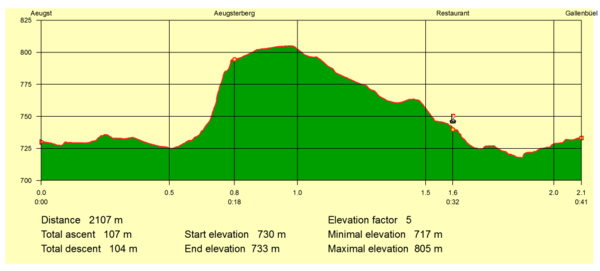DEM: Difference between revisions
(/* Open File:Space.PNGThis function is available in OCAD Mapping Solution.|link=https://www.ocad.com/en/products/ocad-for-cartographyThis function is available in OCAD Orienteering.|link=https://www.ocad.com/en/products/ocad-for-orienteeringThis functi...) |
|||
| (275 intermediate revisions by 12 users not shown) | |||
| Line 1: | Line 1: | ||
A DEM (Digital Elevation Model) contains points with elevation data. Data | A DEM (Digital Elevation Model) contains points with elevation data. DEM Data are based on LIDAR (Light Detection and Ranging) technology measurement, also known as Airborne Laser Scanning. There are DEM with point data arranged in a regular grid with a constant distance between the points. This distance is called cell size. Other DEM contain data points arranged irregularly (cloud-model). | ||
: Read more about this topic: http://en.wikipedia.org/wiki/Digital_elevation_model | : Read more about this topic: http://en.wikipedia.org/wiki/Digital_elevation_model | ||
[[File:DEM.jpg]] | |||
A laser beam splits as it hits objects. The result are multiple returns. The difference between first and last return can show object height. The last return doesn’t always reach the ground. | |||
: [[File:DemImportLas MultipleReturn.jpg]] | |||
: Source: Lohani, Bharat. Airborne Altimetric LiDAR: Principle, Data Collection, Processing and Applications. | |||
==DEM Import Wizard [[File:Space.PNG]][[File:Mas40px.PNG|This function is available in OCAD Mapping Solution.|link=https://www.ocad.com/en/products/ocad-for-cartography]][[File:Ori40px.PNG|This function is available in OCAD Orienteering.|link=https://www.ocad.com/en/products/ocad-for-orienteering]]== | |||
Read more about importing DEM file on the page [[DEM Import Wizard]]. | |||
: [[File: | ==Open [[File:Space.PNG]][[File:Mas40px.PNG|This function is available in OCAD Mapping Solution.|link=https://www.ocad.com/en/products/ocad-for-cartography]][[File:Ori40px.PNG|This function is available in OCAD Orienteering.|link=https://www.ocad.com/en/products/ocad-for-orienteering]][[File:Sta40px.PNG|This function is available in OCAD Starter.|link=https://www.ocad.com/en/products/ocad-for-orienteering]][[File:CS40px.PNG|This function is available in OCAD Course Setting.|link=https://www.ocad.com/en/products/ocad-for-orienteering]]== | ||
Open an OCAD DEM file (*.ocdDem). OCAD 2020 can also open ocdDems created in OCAD 11 and OCAD 12. | |||
The OCAD DEM file is a DEM grid in an OCAD internal file format created in the [[DEM Import Wizard]]. | |||
This file is optimized for fast access to the height values. | |||
For more information (e.g. cell size) about this file open the [[DEM#Info|DEM Information dialog]]. | |||
==Show Frame [[File:Space.PNG]][[File:Mas40px.png|This function is available in OCAD Mapping Solution.|link=https://www.ocad.com/en/products/ocad-for-cartography]][[File:Ori40px.PNG|This function is available in OCAD Orienteering.|link=https://www.ocad.com/en/products/ocad-for-orienteering]][[File:Sta40px.PNG|This function is available in OCAD Starter.|link=https://www.ocad.com/en/products/ocad-for-orienteering]][[File:CS40px.PNG|This function is available in OCAD Course Setting.|link=https://www.ocad.com/en/products/ocad-for-orienteering]]== | |||
Shows blue rectangle with the extent of the loaded DEM. | |||
[[File:DemShowFrame.png]] | |||
When moving the mouse cursor inside the frame the height values is show in the status bar together with the coordinate. | |||
[[File:DemShowFrameStatusBar.png]] | |||
== | ==Resize [[File:Space.PNG]][[File:Mas40px.PNG|This function is available in OCAD Mapping Solution.|link=https://www.ocad.com/en/products/ocad-for-cartography]][[File:Ori40px.PNG|This function is available in OCAD Orienteering.|link=https://www.ocad.com/en/products/ocad-for-orienteering]]== | ||
Resize the loaded OCAD DEM file (make a subset) and save it as a new OCAD DEM file or overwrite the existing one. | |||
[[File:DemResize.png]] | |||
==Info [[File:Space.PNG]][[File:Mas40px.PNG|This function is available in OCAD Mapping Solution.|link=https://www.ocad.com/en/products/ocad-for-cartography]][[File:Ori40px.PNG|This function is available in OCAD Orienteering.|link=https://www.ocad.com/en/products/ocad-for-orienteering]][[File:Sta40px.PNG|This function is available in OCAD Starter.|link=https://www.ocad.com/en/products/ocad-for-orienteering]][[File:CS40px.PNG|This function is available in OCAD Course Setting.|link=https://www.ocad.com/en/products/ocad-for-orienteering]]== | |||
Shows information about OCAD DEM file. | |||
[[File:DemInfo.png]] | |||
When moving the mouse cursor over the file name then the file name with path appears. | |||
== | ==Close [[File:Space.PNG]][[File:Mas40px.PNG|This function is available in OCAD Mapping Solution.|link=https://www.ocad.com/en/products/ocad-for-cartography]][[File:Ori40px.PNG|This function is available in OCAD Orienteering.|link=https://www.ocad.com/en/products/ocad-for-orienteering]][[File:Sta40px.PNG|This function is available in OCAD Starter.|link=https://www.ocad.com/en/products/ocad-for-orienteering]][[File:CS40px.PNG|This function is available in OCAD Course Setting.|link=https://www.ocad.com/en/products/ocad-for-orienteering]]== | ||
:This function | |||
: | |||
This function closes OCAD DEM file. | |||
==Merge DEM [[File:Space.PNG]][[File:Mas40px.PNG|This function is available in OCAD Mapping Solution.|link=https://www.ocad.com/en/products/ocad-for-cartography]][[File:Ori40px.PNG|This function is available in OCAD Orienteering.|link=https://www.ocad.com/en/products/ocad-for-orienteering]]== | |||
Choose '''Merge''' from '''DEM''' menu to merge two different DEMs. | |||
[[File:Merge.PNG]] | |||
* '''DEM 1:''' Choose the first DEM. | |||
* '''DEM 2:''' Choose the second DEM. | |||
The two DEMs must have the same cell size. | |||
: | ==Calculate DEM Difference [[File:Space.PNG]][[File:Mas40px.PNG|This function is available in OCAD Mapping Solution.|link=https://www.ocad.com/en/products/ocad-for-cartography]][[File:Ori40px.PNG|This function is available in OCAD Orienteering.|link=https://www.ocad.com/en/products/ocad-for-orienteering]]== | ||
Choose '''Calculate DEM Difference''' from '''DEM''' menu. The '''Calculate DEM Difference''' dialog box appears. | |||
: | |||
: | |||
: | |||
: | |||
: | [[File:CalculateDEMDifference.PNG]] | ||
Usually it is the difference between a terrain model and a surface model. | |||
* Add ''Upper DEM'' = DSM data file | |||
* Add ''Lower DEM'' = DTM data file | |||
* Click '''OK'''. | |||
In the [[DEM Import Wizard]] it is possible to import DTM and DSM and create the DEM difference in one step. | |||
To visualize the DEM difference choose '''[[DEM#Classify_Vegetation_Height|Classify Vegetation Height]]''' | |||
[[File:Hint.jpg]] The extent of the ''Upper DEM'' and ''Lower DEM'' can be different. OCAD takes the overlapping area for the new DEM. | |||
: | [[File:Hint.jpg]] The cell size of ''Upper DEM'' and ''Lower DEM'' can be different. OCAD takes the cell size of ''Upper DEM'' for the new DEM. | ||
===Example=== | |||
This is an example to show what can result from the '''Calculate DEM Difference''' function. | |||
This is a DTM (Digital Terrain Model) with a cell size of 5m shown as hypsometric map: | |||
[[File:DTM5mHypso.PNG|300px]] | |||
The next picture shows the DSM (Digital Surface Model) of the same area with a cell size of 2m as hypsometric map. The buildings (northern part) and forest (south western part) are slightly visible. | |||
[[File:DSM2mHypso.PNG|300px]] | |||
The next picture shows a '''Difference DEM''' with a cell size of 2m shown as raster background map after calculating the '''DEM Difference'''. In addition, heights were colored using the '''[[DEM#Classify Vegetation Height|Classify Vegetation Height]]''' function. | |||
[[File:ClassifiedDifferenceDEM.PNG|300px]] | |||
Back to [[ | * The area with no difference of the DTM and the DSM are displayed white. | ||
* A height difference up to 15m appears red. | |||
* The greater the difference, the greener an area appears. | |||
When moving the mouse cursor over the map the difference is shown in the '''[[Graphical User Interface#Status Bar|Status Bar]]'''. | |||
''Data source: Test data Wabern from swisstopo.'' | |||
==Create Contour Lines [[File:Space.PNG]][[File:Mas40px.PNG|This function is available in OCAD Mapping Solution.|link=https://www.ocad.com/en/products/ocad-for-cartography]][[File:Ori40px.PNG|This function is available in OCAD Orienteering.|link=https://www.ocad.com/en/products/ocad-for-orienteering]]== | |||
Choose '''Create Contour Lines''' from '''DEM''' menu. The '''Create Contour Lines''' dialog box appears. | |||
Read more about this function on the page [[DEM Import Wizard#Create Contour Lines|DEM Import Wizard]]. | |||
==Create Hypsometric Map [[File:Space.PNG]][[File:Mas40px.PNG|This function is available in OCAD Mapping Solution.|link=https://www.ocad.com/en/products/ocad-for-cartography]][[File:Ori40px.PNG|This function is available in OCAD Orienteering.|link=https://www.ocad.com/en/products/ocad-for-orienteering]]== | |||
Choose '''Create Hypsometric Map''' from '''DEM''' menu. The '''Create Hypsometric Map''' dialog box appears. | |||
Read more about this function on the page [[DEM Import Wizard#Create Hypsometric Map|DEM Import Wizard]]. | |||
==Create Hill Shading [[File:Space.PNG]][[File:Mas40px.PNG|This function is available in OCAD Mapping Solution.|link=https://www.ocad.com/en/products/ocad-for-cartography]][[File:Ori40px.PNG|This function is available in OCAD Orienteering.|link=https://www.ocad.com/en/products/ocad-for-orienteering]]== | |||
Choose '''Create Hill Shading''' from '''DEM''' menu. The '''Create Hill Shading''' dialog box appears. | |||
Read more about this function on the page [[DEM Import Wizard#Create Hill Shading|DEM Import Wizard]]. | |||
==Calculate Slope Gradient [[File:Space.PNG]][[File:Mas40px.PNG|This function is available in OCAD Mapping Solution.|link=https://www.ocad.com/en/products/ocad-for-cartography]][[File:Ori40px.PNG|This function is available in OCAD Orienteering.|link=https://www.ocad.com/en/products/ocad-for-orienteering]]== | |||
Choose '''Calculate Slope Gradient''' from '''DEM''' menu. The '''Calculate Slope Gradient''' dialog box appears. | |||
Read more about this function on the page [[DEM Import Wizard#Calculate Slope Gradient|DEM Import Wizard]]. | |||
==Classify Vegetation Height [[File:Space.PNG]][[File:Mas40px.PNG|This function is available in OCAD Mapping Solution.|link=https://www.ocad.com/en/products/ocad-for-cartography]][[File:Ori40px.PNG|This function is available in OCAD Orienteering.|link=https://www.ocad.com/en/products/ocad-for-orienteering]]== | |||
Choose '''Classify Vegetation Height''' from '''DEM''' menu. The '''Classify Vegetation Height''' dialog box appears. | |||
Read more about this function on the page [[DEM Import Wizard#Classify Vegetation Height|DEM Import Wizard]]. | |||
==Merge Contour Lines By Selected Symbols [[File:Space.PNG]][[File:Mas40px.PNG|This function is available in OCAD Mapping Solution.|link=https://www.ocad.com/en/products/ocad-for-cartography]][[File:Ori40px.PNG|This function is available in OCAD Orienteering.|link=https://www.ocad.com/en/products/ocad-for-orienteering]]== | |||
This is an obsolete function. It is still in the latest OCAD version due to compability issues. OCAD merges the contour lines automatically. | |||
* Select the contour line symbols | |||
* Choose '''Merge Contour Lines By Selected Symbols''' from DEM menu. | |||
* The '''Merge Contour Lines By Selected Symbols''' dialog box appears. | |||
[[File:MergeContourLinesBySelectedSymbols.png]] | |||
==Create Profile [[File:Space.PNG]][[File:Mas40px.PNG|This function is available in OCAD Mapping Solution.|link=https://www.ocad.com/en/products/ocad-for-cartography]][[File:Ori40px.PNG|This function is available in OCAD Orienteering.|link=https://www.ocad.com/en/products/ocad-for-orienteering]][[File:Sta40px.PNG|This function is available in OCAD Starter.|link=https://www.ocad.com/en/products/ocad-for-orienteering]][[File:CS40px.PNG|This function is available in OCAD Course Setting.|link=https://www.ocad.com/en/products/ocad-for-orienteering]]== | |||
[[File:ProfileExample.PNG|600px]] | |||
Find more information about this function on the '''[[DEM Profile]]''' page. | |||
==Export [[File:Space.PNG]][[File:Mas40px.PNG|This function is available in OCAD Mapping Solution.|link=https://www.ocad.com/en/products/ocad-for-cartography]][[File:Ori40px.PNG|This function is available in OCAD Orienteering.|link=https://www.ocad.com/en/products/ocad-for-orienteering]]== | |||
* Choose '''Export''' from DEM menu. | |||
* The '''DEM Export''' dialog box appears. | |||
[[File:DEMExport.PNG]] | |||
The function exports the loaded DEM file to the following formats: | |||
* ESRI ASCII Grid | |||
::Select '''Create tiles''' for large DEMs to create tiles from 1001x1001 points. | |||
* ASCII Grid XYZ | |||
==LiDAR Point Cloud Manager [[File:Space.PNG]][[File:Mas40px.PNG|This function is available in OCAD Mapping Solution.|link=https://www.ocad.com/en/products/ocad-for-cartography]][[File:Ori40px.PNG|This function is available in OCAD Orienteering.|link=https://www.ocad.com/en/products/ocad-for-orienteering]]== | |||
The '''LiDAR Point Cloud Manager''' analyzes the vegetation within the forest and creates a vegetation raster map. | |||
Learn more on the '''[[LiDAR Point Cloud Manager]]''' page. | |||
---- | |||
Back to [[Main Page]] | |||
Revision as of 13:48, 1 April 2020
A DEM (Digital Elevation Model) contains points with elevation data. DEM Data are based on LIDAR (Light Detection and Ranging) technology measurement, also known as Airborne Laser Scanning. There are DEM with point data arranged in a regular grid with a constant distance between the points. This distance is called cell size. Other DEM contain data points arranged irregularly (cloud-model).
- Read more about this topic: http://en.wikipedia.org/wiki/Digital_elevation_model
A laser beam splits as it hits objects. The result are multiple returns. The difference between first and last return can show object height. The last return doesn’t always reach the ground.
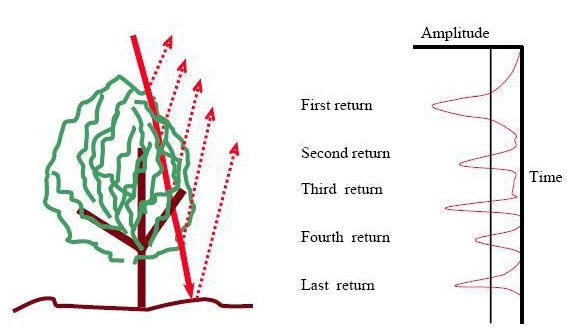
- Source: Lohani, Bharat. Airborne Altimetric LiDAR: Principle, Data Collection, Processing and Applications.
DEM Import Wizard 


Read more about importing DEM file on the page DEM Import Wizard.
Open 




Open an OCAD DEM file (*.ocdDem). OCAD 2020 can also open ocdDems created in OCAD 11 and OCAD 12.
The OCAD DEM file is a DEM grid in an OCAD internal file format created in the DEM Import Wizard. This file is optimized for fast access to the height values.
For more information (e.g. cell size) about this file open the DEM Information dialog.
Show Frame 




Shows blue rectangle with the extent of the loaded DEM.
When moving the mouse cursor inside the frame the height values is show in the status bar together with the coordinate.
Resize 


Resize the loaded OCAD DEM file (make a subset) and save it as a new OCAD DEM file or overwrite the existing one.
Info 




Shows information about OCAD DEM file.
When moving the mouse cursor over the file name then the file name with path appears.
Close 




This function closes OCAD DEM file.
Merge DEM 


Choose Merge from DEM menu to merge two different DEMs.
- DEM 1: Choose the first DEM.
- DEM 2: Choose the second DEM.
The two DEMs must have the same cell size.
Calculate DEM Difference 


Choose Calculate DEM Difference from DEM menu. The Calculate DEM Difference dialog box appears.
Usually it is the difference between a terrain model and a surface model.
- Add Upper DEM = DSM data file
- Add Lower DEM = DTM data file
- Click OK.
In the DEM Import Wizard it is possible to import DTM and DSM and create the DEM difference in one step.
To visualize the DEM difference choose Classify Vegetation Height
![]() The extent of the Upper DEM and Lower DEM can be different. OCAD takes the overlapping area for the new DEM.
The extent of the Upper DEM and Lower DEM can be different. OCAD takes the overlapping area for the new DEM.
![]() The cell size of Upper DEM and Lower DEM can be different. OCAD takes the cell size of Upper DEM for the new DEM.
The cell size of Upper DEM and Lower DEM can be different. OCAD takes the cell size of Upper DEM for the new DEM.
Example
This is an example to show what can result from the Calculate DEM Difference function.
This is a DTM (Digital Terrain Model) with a cell size of 5m shown as hypsometric map:
The next picture shows the DSM (Digital Surface Model) of the same area with a cell size of 2m as hypsometric map. The buildings (northern part) and forest (south western part) are slightly visible.
The next picture shows a Difference DEM with a cell size of 2m shown as raster background map after calculating the DEM Difference. In addition, heights were colored using the Classify Vegetation Height function.
- The area with no difference of the DTM and the DSM are displayed white.
- A height difference up to 15m appears red.
- The greater the difference, the greener an area appears.
When moving the mouse cursor over the map the difference is shown in the Status Bar.
Data source: Test data Wabern from swisstopo.
Create Contour Lines 


Choose Create Contour Lines from DEM menu. The Create Contour Lines dialog box appears.
Read more about this function on the page DEM Import Wizard.
Create Hypsometric Map 


Choose Create Hypsometric Map from DEM menu. The Create Hypsometric Map dialog box appears.
Read more about this function on the page DEM Import Wizard.
Create Hill Shading 


Choose Create Hill Shading from DEM menu. The Create Hill Shading dialog box appears.
Read more about this function on the page DEM Import Wizard.
Calculate Slope Gradient 


Choose Calculate Slope Gradient from DEM menu. The Calculate Slope Gradient dialog box appears.
Read more about this function on the page DEM Import Wizard.
Classify Vegetation Height 


Choose Classify Vegetation Height from DEM menu. The Classify Vegetation Height dialog box appears.
Read more about this function on the page DEM Import Wizard.
Merge Contour Lines By Selected Symbols 


This is an obsolete function. It is still in the latest OCAD version due to compability issues. OCAD merges the contour lines automatically.
- Select the contour line symbols
- Choose Merge Contour Lines By Selected Symbols from DEM menu.
- The Merge Contour Lines By Selected Symbols dialog box appears.
Create Profile 




Find more information about this function on the DEM Profile page.
Export 


- Choose Export from DEM menu.
- The DEM Export dialog box appears.
The function exports the loaded DEM file to the following formats:
- ESRI ASCII Grid
- Select Create tiles for large DEMs to create tiles from 1001x1001 points.
- ASCII Grid XYZ
LiDAR Point Cloud Manager 


The LiDAR Point Cloud Manager analyzes the vegetation within the forest and creates a vegetation raster map. Learn more on the LiDAR Point Cloud Manager page.
Back to Main Page



